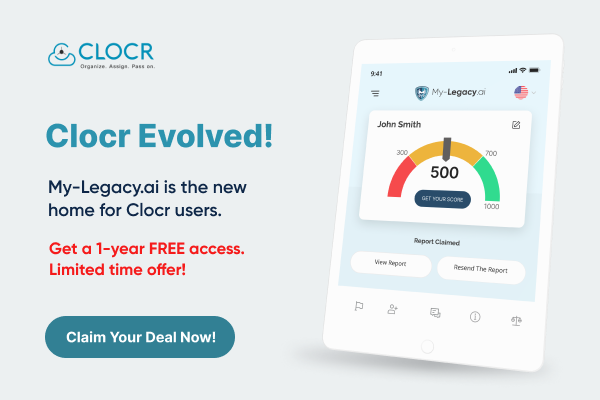The high tides of the digital revolution have changed ways of living. We produce, circulate, and store confidential information on internet based platforms. In this process, we leave behind a digital legacy when we pass away. However, in the 2017 Digital Death Survey by the Digital Legacy Association, 83% of participants stated that they had made no provisions for their digital estate.
Unlike our tangible assets that one passes down to their next kin with legacy planning, what occurs to our digital assets after we pass away? The internet has been the most significant and most “revolutionary” force after the industrial revolution. As a result, we are increasingly engaged in the internet for various purposes. Yet, managing our digital presence after our death seldom crosses our minds.
What is a Digital Legacy?
In this digital era, digital legacy planning is no longer an option but a necessity when much of life is shared online. Planning on what happens to your digital assets not only secures your invaluable digital data but also saves your loved ones from the trouble of managing them when grieving. Let’s delve deeper into what digital legacy means.
All the digital assets that we accumulate in our lifetime will inevitably become a part of our digital legacy. Your online activities leave a digital footprint. Everything you write, store, post, your online transactions, and all the devices you use to access the internet are your digital assets. So, what should you include in your digital legacy?
What to include in your digital legacy?
Ticking all the boxes while taking inventory of your digital legacy’s contents is the first step towards protecting it. Assets that define your digital presence may or may not have a monetary value. You can include a long list of digital assets in your digital legacy planning. It is best if you determine what legacies you wish to safeguard after your death.
Take your time to identify the online accounts that are precious to you and want to hand them over to loved ones. Today’s typical person has more than 100 online accounts. Are they all required? Could you converge three distinct photo-sharing and storage websites into one account? You could consider such instances while legacy planning.
What are our digital assets?
Any files, documents, information, accounts, and images you can access on a desktop, tablet, smartphone, e-reader, and even your electronic devices are considered digital assets. Your digital accounts may include the following:
- Social media accounts (Facebook, Instagram)
- Email accounts (Gmail, Outlook, Yahoo)
- Personal Blogs, Websites, Review sites
- Online shopping accounts (Amazon, eBay)
- Cloud storage for digital data (Dropbox, Google Drive, One Drive)
- Subscribed streaming platforms (Netflix, Spotify, Amazon Prime)
- Online payment services & wallets (Paypal)
- Online apps and services downloaded on your digital devices.
- Cryptocurrencies, NFTs
- All your digital devices (Laptop, iPad, Smartphones)
List all your accounts in one location and their passwords. It is required when creating an inventory of your digital assets. Recognizing the components of your digital legacy is the first step in managing it. Follow these steps to set up your digital legacy.
How to set up Digital legacy?
You generally don’t think about your digital legacy when planning your legacy. Here are a few pointers for setting up a digital legacy now that you understand what it is and why it’s crucial.
Make a list of digital assets
The first and foremost step towards setting up your digital legacy planning is to make a list of your digital assets. Take account of every social media, email service, streaming service, Cloud storage, photos, important documents, online payment service, web service, and digital device you own. You should include everything you feel is a crucial part of your legacy.
Manage passwords for digital assets
When listing your digital assets, it is equally important to manage their passwords. If you only have a handful of digital assets, think about creating passwords for each item following the advice given by each service provider. List all passwords on paper sealed as part of your will or in a straightforward spreadsheet on your desktop.
Select a digital executor
A friend you can trust or your conventional will’s executor can serve as your digital executor. Make sure the person you choose has sound technological understanding. The digital executor will be in charge if you wish to close your online accounts. Your digital executor would need to understand how to download and organize your photos and videos.
Prepare a social media will
A will outlines your preferences regarding your assets, property, and other matters after you pass away. Similar to a conventional will, a social media will specify your wishes for your social media accounts and other digital assets. Make sure your will’s executor knows your intentions for your digital legacy.
Specify instructions for your digital assets
RUFADAA a governs access to digital belongings after a person’s death, and 47 states since 2015 have adopted it. It’s better to write down detailed instructions for handling your digital assets and protecting your digital legacy after you pass away if your state has adopted the RUFADA Act.
Pass on legacy to your next kin with clear instructions to save them from confusion. Specifying your wishes for your digital assets will help your family members fulfill your wish. Without detailed instructions, your digital executor and family members might go through strenuous legal processes to manage your digital legacy.
Steps to manage your Digital Legacy
It is your sole responsibility to understand you should manage your digital legacy. It is a task that no one else should do in your stead. Think of all the digital accounts that are important to you. Consider your social media accounts, internet-only banks, cloud storage services, and other online accounts that house your valuable memory or data.
Consider what is essential to you in all these accounts and whether the assets they include will also be necessary to your family if you die. Give directions on how to access these digital items, irrespective of what they are. Your family will benefit from accessing your digital legacy or preserving it as per your last wishes.
Importance of Digital legacy
Would you prefer your Facebook account deleted from the internet, or do you wish to turn it into a memorial page? Do you want your online credits, bitcoins, and images to be passed down to your next kin? What do you wish to happen with your blog compositions? These are the exact questions that will help you understand the importance of digital legacy.
To manage digital legacy is to safeguard them after your death. Maintaining your digital belongings as the world and technology change and advance is critical. You run the risk of losing all assets you have online if you don’t keep track of it. Your thoughtful preparation may provide emotional and monetary benefits to your loved ones.
Conclusion
Your end-of-life planning may need to incorporate a digital legacy plan now that we live in a digital world. Our digital assets either have emotional or monetary values attached to them. We must ensure they are passed down in the right hands or dealt with according to your wishes. Digital legacy planning protects your digital assets and ensures that your family can still access their benefits after your passing.
We at Clocr provide you with services like Social Media Will, Digital Estate, and many more. You can have a secured legacy plan for your digital asset with our service of Digital Estate and help your loved one know your wishes on how to handle them in your absence. Our services, such as Digital Vault and Digital Estate, will help protect your digital assets and let your wishes known to your next kin. Join Clocr today to leave behind an unforgettable digital legacy.




